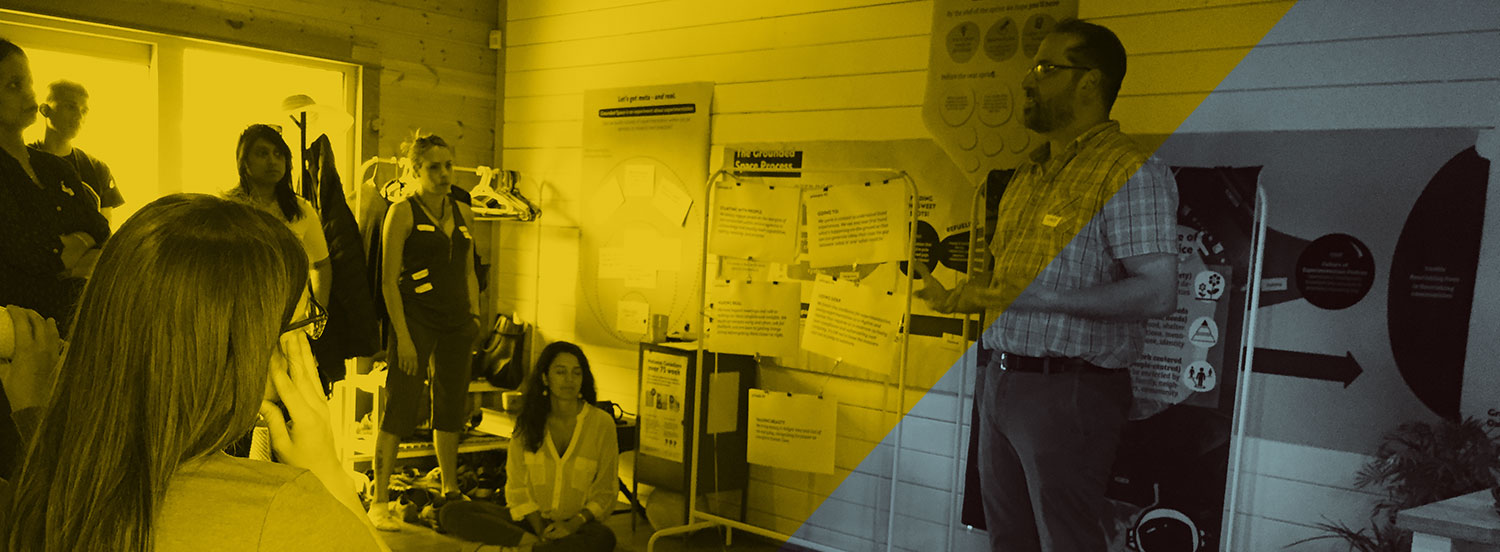Categories
1. Resources.
We’re not funded for social R&D and we’re not private corporations; we’re charities. We don’t have drawers of cash, and even if we did, there would be an expectation that those monies would get spent on concrete service needs and priorities rather than on an R&D process that has no explicit outputs or outcomes. There is extraordinary pressure to address exigent needs rather than investing in processes that might shape the future.
As you know, there is no government infrastructure for social research and development, so we have to cobble funding together however we can—grants, loans, lean administration budgets, etc. And because sustained funding isn’t a given, it adds stress because it means that everything we build feels fragile and vulnerable. It’s like we’re building sand castles as the tide comes in.
And it’s so hard on our leadership teams. They were stretched long before social R&D happened. Their other responsibilities meant workweeks that regularly exceeded 40 hours. It’s no easy task to run programs or organizations, never mind retooling and repurposing them. Getting involved in social R&D adds 10 – 20 hours a week to schedules. It’s not sustainable, but what do you do when there is a vision and an imperative, but no funding? You do what you can.
2. Pace.
There are a lot of roles, processes, and structures that comprise an organization. Especially if it has been around for a while. It needs time to make things work—re-allocating resources, recruiting internal teams and freeing up some of their time, aligning incredibly busy schedules, sorting out internal and external messaging, coordinating logistics, etc. And of course, none of these pieces are static when we are iterating the R&D model itself. There is a steep learning curve for organizations and it takes time to do R&D properly.
Organizations require at least 5-year time bites for undertaking social R&D, not 1 – 3 years. Short-term funding puts pressure on organizations to go through an intensive R&D process that chafes against multiple organizational and regulatory systems and functions. It burns people out and builds resentment. There is an urgency to produce something worthwhile before the money runs out, something that would justify the need for social R&D and associated expenditures. But it means 5 years of work gets compressed into 2 years or less.
To compound this, the learning/iteration cycle that we do manage to eke out is too long. A single cycle of research, analysis, playback, idea generation and prototyping can take several months to over a year. That’s too way long. The cycles should be shorter and there should be more of them. But so far, it’s been hard to make that happen. The problem doesn’t lie with the method itself, but with the need to conduct it at a pace that is both effective and that is manageable by organizations. We haven’t found how to do that yet.
3. Communication.
Leadership and managers are accustomed to knowing what is going on in their agencies, what sort of decisions are being made, and the rationale behind them. Rapid-fire iteration means completely new directions or 180’s can occur in a relatively short period of time (hours or days). That is hard to take in high-risk, high-accountability systems. Leadership/managers feel constantly behind and may feel slighted or upset that they haven’t been part of important decisions or iterations. Or wondering why some people were somehow involved, or knew, but not others. They worry that perhaps they haven’t given their best, or been sufficiently available. If only they could keep up. They want to contribute and open doors, but they can’t flip the pages fast enough.
Change is hard to take, especially when it is happening in one’s backyard and one doesn’t feel in control of it. “When did that happen?” “Who decided that?” “I thought we agreed/were told we were going to do ‘x’—why are we talking about ‘y’?” This is only exacerbated when research, playbacks, decisions or iterations produce a “problem” for the organization that make more work for leadership/managers and which may require them to go into damage control mode.
Such problems are bound to occur when local and quick decisions are part of the process, versus consensus or authorization, and when the method itself is about surfacing gaps in one’s agencies, questioning conventional values, roles or practices, and when it is not a system-managed process. This sort of thing triggers an impulse to better manage R&D processes so that these problems don’t occur, so that there are clearer processes in place that will prevent their recurrence. Which, of course, is a hazardous approach. Once R&D processes become the legitimate subject of systemization, it is hard to know when to stop; there is so much clarifying, structuring, and cleaning up that could be done. But then, not being on the same page with everyone else, not knowing what changes are happening, not knowing who knows what or has been part of what decision, is hard.
It is hard enough to explain what we are about to our internal and external stakeholders—how much more so when everything keeps changing? Things like our learning, hunches, roles, models, prototypes, narratives, etc.

4. Culture clash.
The cultures of social service organizations are about predictability, consistency, quality and control. The culture of social R&D is about interrogation, emergence, creativity and experiment. Social services are complicated and interconnected systems that require skilled managers, navigators and adjustors. Social R&D requires fearless questioners and makers. Social services try to avoid problems, eschewing mistakes that add more work/trouble to an already stressful environment; social R&D encourages and requires lots and lots of failure. Social services is about nurturing and supporting one another and celebrating what is done well; social R&D is about naming gaps and pain points and mobilizing against the status quo.
The very concept of “innovation” has a structural prejudice against what exists—that it is somehow insufficient, inadequate, and needs to be improved upon and/or surpassed. There is an inherent tension between what is on offer and what is being envisioned—how this unfortunate tension is handled is critical because, done poorly, it can alienate employees and teams who are doing excellent work.
At some point, leadership will face a threshold around their personal and professional comfort levels. How much interrogation can they tolerate? How much unpredictability? How much emergence? How much change and upset? What is required to run an organization is quite different than what is required to disrupt it.

